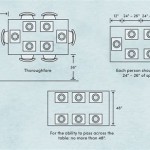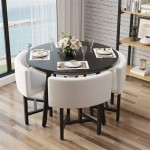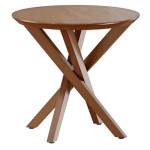Outdoor Round Table With Umbrella Hole: A Guide to Selection and Maintenance
Outdoor living spaces extend the comfort and functionality of a home. A key element in creating a comfortable and inviting outdoor area is outdoor furniture. Among the many options available, the outdoor round table with an umbrella hole offers a versatile and practical solution for dining and relaxation. This article delves into the features, benefits, selection criteria, and maintenance of outdoor round tables with umbrella holes, providing a comprehensive guide for prospective buyers and current owners.
Understanding the Benefits of a Round Table with an Umbrella Hole
Round tables foster a sense of inclusivity and facilitate conversation. The circular shape eliminates rigid hierarchy, making it easier for everyone seated to see and interact with one another. This is particularly beneficial for social gatherings, family meals, and casual conversations in the outdoor setting.
The inclusion of an umbrella hole enhances the functionality of the table. It allows for the secure placement of a patio umbrella, providing shade and protection from the sun's harmful ultraviolet rays. This feature is particularly valuable during the warmer months, allowing for comfortable outdoor enjoyment even during peak sunlight hours. The shade also helps to keep food and drinks cooler for a longer period.
Outdoor round tables with umbrella holes are available in a wide range of materials, sizes, and styles, making it easy to find a table that complements existing outdoor décor and meets specific needs. Whether the aesthetic preference is for a rustic wood, sleek metal, or durable resin, there is a round table with an umbrella hole to suit nearly every taste and budget.
Key Considerations When Selecting an Outdoor Round Table
The material of the table is a critical factor influencing durability, maintenance, and aesthetic appeal. Common materials include wood, metal, resin, and stone. Each material offers unique advantages and disadvantages that need to be carefully considered in relation to the intended use and environment.
Wood offers a natural and warm aesthetic. Teak, cedar, and acacia are popular choices due to their inherent resistance to rot and insects. However, wood requires regular maintenance, such as cleaning, staining, or oiling, to preserve its appearance and structural integrity. Without proper care, wood can weather, crack, or warp over time.
Metal tables, typically made from aluminum or wrought iron, are known for their strength and durability. Aluminum is lightweight and resistant to rust, while wrought iron is heavier and more ornate. Metal tables may require powder coating or other finishes to protect them from corrosion. They can also become hot in direct sunlight, so it is essential to consider this when choosing a seating arrangement and table location.
Resin tables, also known as plastic or composite tables, are a low-maintenance option. They are resistant to fading, cracking, and rotting, making them ideal for harsh weather conditions. Resin tables are often more affordable than wood or metal options, but they may not offer the same level of aesthetic appeal. However, high-quality resin tables can mimic the look of natural materials and offer excellent durability.
Stone tables, such as granite or marble, offer a luxurious and durable option. They are naturally resistant to weather and require minimal maintenance. Stone tables are heavy and can be difficult to move, making them best suited for permanent outdoor settings. They can also be expensive compared to other materials.
The size of the table should be proportionate to the available space and the number of people who will be using it. Consider the diameter of the table and the number of chairs that will comfortably fit around it. A small round table (36-48 inches in diameter) is suitable for intimate settings with two to four people, while a larger round table (54-72 inches in diameter) can accommodate larger groups of six to eight people. Measure the intended area to ensure adequate space for the table and chairs, allowing for comfortable movement around the seating arrangement.
The style of the table should complement the existing outdoor décor and reflect personal preferences. There are many styles available, ranging from traditional to contemporary. Consider the color, finish, and design details of the table to ensure it blends seamlessly with the overall aesthetic of the outdoor space. For example, a rustic wood table may be ideal for a country-style patio, while a sleek metal table may be better suited for a modern outdoor space. Look for tables with details that enhance your patio style, such as scrolled legs, intricate weave patterns, or unique tabletop designs.
The stability of the table is crucial for safety and usability. Ensure that the table has a sturdy base and does not wobble or tip easily. Look for tables with adjustable feet to compensate for uneven surfaces. The umbrella hole should be reinforced to prevent cracking or damage from the umbrella pole. The weight of the table is also a factor to consider, particularly if it will be placed in a windy area. A heavier table will be less likely to be blown over by strong gusts of wind.
Umbrella Hole Specifications and Considerations
The diameter of the umbrella hole is a critical consideration. It should be compatible with the umbrella pole being used. Standard umbrella holes are typically 1.5 to 2 inches in diameter, but it is essential to measure the umbrella pole to ensure a proper fit. Some tables may include adapters or inserts to accommodate different pole sizes.
The presence of an umbrella base is essential for stability. The umbrella base provides additional support and prevents the umbrella from tipping over in windy conditions. The base should be heavy enough to adequately support the umbrella. Common materials for umbrella bases include concrete, metal, and resin. The base should also be aesthetically pleasing and complement the overall design of the table and umbrella.
The location and orientation of the table can impact the effectiveness of the umbrella. Consider the direction of the sun and the prevailing wind patterns. Position the table so that the umbrella provides optimal shade during peak sunlight hours. Be mindful of potential hazards, such as low-hanging branches or overhead power lines. Ensure that the umbrella is properly secured to prevent it from being blown over or causing damage. Regularly inspect the umbrella and base for any signs of wear or damage.
Maintaining Your Outdoor Round Table for Longevity
Regular cleaning is essential for maintaining the appearance and prolonging the lifespan of the table. The cleaning method will vary depending on the material of the table. Wood tables should be cleaned with a mild soap and water solution and then treated with a wood protectant or sealant. Metal tables can be cleaned with a damp cloth and mild detergent. Resin tables are typically easy to clean with soap and water. Avoid using harsh chemicals or abrasive cleaners, as they can damage the finish.
Proper storage during the off-season is critical for preventing damage from the elements. If possible, store the table indoors or in a covered area. If outdoor storage is necessary, cover the table with a waterproof tarp to protect it from rain, snow, and sun. Disassemble the table if possible to save space and prevent stress on the joints. Store the umbrella separately to prevent damage to the table.
Periodic inspections and repairs can help to identify and address potential problems before they escalate. Check for signs of rust, rot, or cracking. Tighten any loose screws or bolts. Repair any damaged areas immediately to prevent further deterioration. Consider hiring a professional to repair or refinish the table if necessary.
Protecting the table from the elements can extend its lifespan significantly. Use furniture covers to protect the table from rain, snow, and sun when not in use. Apply a sealant or protectant to wood tables to prevent moisture damage. Avoid placing the table directly on wet surfaces, as this can lead to rot or corrosion. Consider using coasters and placemats to protect the tabletop from scratches and spills.
Choosing the right outdoor round table with an umbrella hole involves careful consideration of material, size, style, umbrella compatibility, and maintenance requirements. By understanding these factors, homeowners can select a table that provides years of enjoyment and enhances their outdoor living space.

Round Patio Dining Table With Umbrella Hole Black Captiva Designs

Ulax Furniture Black Round Metal Outdoor Dining Table With 1 57 In Umbrella Hole Hd 970381 The Home

Ulax Furniture Black Round Metal Outdoor Dining Table With 1 57 In Umbrella Hole Hd 970381 The Home

5pc Outdoor Dining Set With Wicker Chairs Cushions Round Metal Table Umbrella Hole Blue Captiva Designs

48 Round Patio Dining Table With Umbrella Hole Broe Wellfor

Phi Villa Black Round Metal Patio Outdoor Dining Table With 1 97 In Umbrella Hole And Wood Look Tabletop Thd Pv 096 B The Home

Outsunny Patio Dining Table With Umbrella Hole Round Outdoor Bistro For Garden Lawn Backyard Green Walmart Com

Mondawe Patio Table Round Outdoor Dining 52 In W X L With Umbrella Hole Ma Gcabq Hf31a The Home

Livingandhome 105cm Patio Garden Round Rattan Glass Table With Umbrella Hole Black

48 Metal Round Dining Table With 1 97 Umbrella Hole Black Captiva Designs








